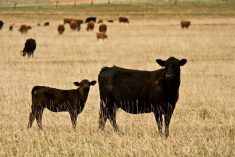Chicago | Reuters –– The number of cattle placed into U.S. feedlots in April jumped seven per cent from a year earlier, according to a government report on Friday, far exceeding most analysts’ forecasts.
Feedlots were still operating at a loss, analysts said. But lower prices for young calves allowed feedlots to buy more of them for fattening, which helped shore up sagging bottom lines.
The U.S. Department of Agriculture’s data showed the number of heavier cattle placed in April rose almost 12 per cent from the year-ago month. Analysts said this could pressure prices for slaughter-ready animals in the fourth quarter.
Read Also

U.S. grains: Soybeans touch 16-month high, wheat firm on Chinese demand hopes
Chicago soybean futures hit 16-month highs on Monday on expectations China will restart large-scale U.S. soy buying after the two countries reached a deal to de-escalate their trade war.
“There are a lot of big cattle out there that are getting placed. If you don’t have a drought, and you’ve got grass, there is an incentive to keep them on pasture longer,” said University of Missouri livestock economist Ron Plain.
Friday’s USDA report showed April placements at 1.664 million head, up seven per cent from 1.548 million last year. It was well above analysts’ average forecast of 1.536 million and the highest for the month of April since 1.738 million in 2013.
USDA put the feedlot cattle supply as of May 1 at 10.783 million head, up one per cent from 10.64 million a year ago. Analysts, on average, had forecast a marginal increase.
The government said the number of cattle sold to packers, or marketings, rose one per cent in April from a year ago, to 1.658 million head.
Analysts projected a 2.4 per cent increase from 1.639 million last year.
Plain called the placement result “a bearish surprise” led by the dramatic improvement in the financial situation at feedlots.
Jessica Sampson, an economist with the Colorado-based Livestock Marketing Information Center, said that although estimated feedlot margins in April were at a loss of $5.98 per head of cattle, it was still a dramatic improvement over the $105.38 per head loss in March (all figures US$).
Strong April placements were largely reported in the southern Plains where last year they were dramatically smaller, said Sampson.
Analysts said USDA’s data may pressure Chicago Mercantile Exchange live cattle futures’, with the October and December contracts down as much as one cent per pound — that despite market losses on Friday before the report’s release.
— Theopolis Waters reports on livestock markets for Reuters from Chicago.











